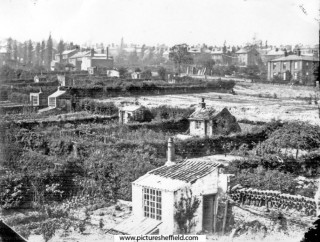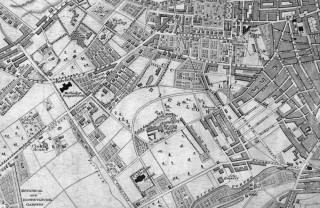The Gardens of Broomhall
Not many people know that Broomhall, along with its neighbouring areas of Sharrow and Little Sheffield, were once famous for its market gardens.
Local photographer and woodcarver Arthur Hayball took a photograph from the back of his house on Hanover Street in the 1850s showing parts of the gardens near the present Brunswick Street (see right).
Gardens are also evident on some of the older maps.
We looked it up in Robert Eadon Leader’s book from 1876, ‘Reminisciences of Old Sheffield, its Streets and its People’ to find out more. He shares an amazing account of the different garden owners, some of which didn’t necessarily live in the area:
Suburban Gardens
“… about 25 years ago was destroyed a plot of gardens that had extended from the top of Young street to Broomhall Street. There were some others that have disappeared, to make room for buildings about the General Cemetery and Broomhall Mill.
When all the above gardens were in existence,” said Mr. Wragg, “I believe one out of every three working men had a garden, which he cultivated more for pleasure than profit. This was far better than his present gambling propensities ; but further, there were not a few instances in which the working man’s garden assisted him to clothe his family, or to pay off debts, unavoidably contracted, by the sale of the fruit from his pear or apple trees. Now, there are no such places for a working man to resort to in his spare time, except for those who are members of some Land Society outside the town. It is said he may resort to the Library, or peruse his book at home; that he can amuse himself by holding communication with the great men of past ages ; but all such talk is a delusion. Bodily toil and mental discipline will not go hand in hand, or blend…
A member of our company mentioned the splendid bed of ranunculuses which a resident in one of the houses still standing opposite the top of Broomhall street, used to show…The vicinity of Hanover street used to be marked out like a chess board by these gardens, and Middleton had one, near the corner of Broomspring lane and Hanover street. The top part of it forms now part of Hanover Street, and the bottom extended behind the houses of Mr. Owen, the draper, which face to Broomspring lane. Afterwards, he showed his skill in one of those previously spoken of, on Glossop road — where Charles Thompson’s cab premises are now, then belonging to the Water Company — having gone there by reason of his neighbour, John Burton, the Quaker, buying a garden for him.
Mr. Wragg believed that the last possessor of Middleton’s garden, near Mr. Owen’s houses, was the late Mr. Bennett, grocer, Church street, elder brother of the present Mr. Bennett, who succeeded him in his business. Joshua Wilkinson had the next garden above, and he sold it to William Melluish, the last survivor among the many South Devon Militiamen who settled in Sheffield after the disbanding of the regiment. The garden above was Mr. Swift’s, the father of Mr. G. E. Swift, in the steel trade, in Blonk Street. At the front of Spring Lane was Samuel Padley’s (a Quaker), the father of Mr. Padley, of the firm of Padley, Parkin, & Co., silversmiths, in Watson’s walk. The late Mr. Bramhall, one of the managers of Messrs. Piodgers and Sons, and Mr. Staniforth, grocer, of Broad lane, had gardens hereabouts. Mr. Ptoger Brown was the last who had Mr. Staniforth’s.
Just below, and behind Josh. Ingle’s house, an old woman of the name of Savage had a garden, and did all the gardening herself. The late Mr. B. Hinchcliffe had a garden in this piece, and there is a tradition that the late Mr. John Holland occupied a garden here, but his nearest friends are incredulous about it. The story is that an old man, a relative, did the gardening for him, in which case it may possibly have been his uncle Amos. A file cutter, afterwards a silver stamper, named William Hague, had the first garden opposite old Mrs. Savage’s. Being a frugal man he saved money, by means of which he built the houses at the bottom of Broomspring lane, and opened a grocer’s shop at the corner.
The last person who had Mr. Hague’s garden was Mr. Worth, the joiner and builder. Mr. Turner, the Sheriff’s officer in Campo lane, had also a garden ; so had Mr. Taylor, of the Commercial Inn, Haymarket, now destroyed by the making of the new street into Norfolk street ; and Mr. Theaker just by, for many years the only coffee-house keeper in the town, had two up to the time of their destruction. “
Extract taken from Robert Eadon Leader’s book, ‘Reminisciences of Old Sheffield, its Streets and its People. Publisher: Leader & sons, Independent office. 1876. (SALS 942.821)











No Comments
Add a comment about this page